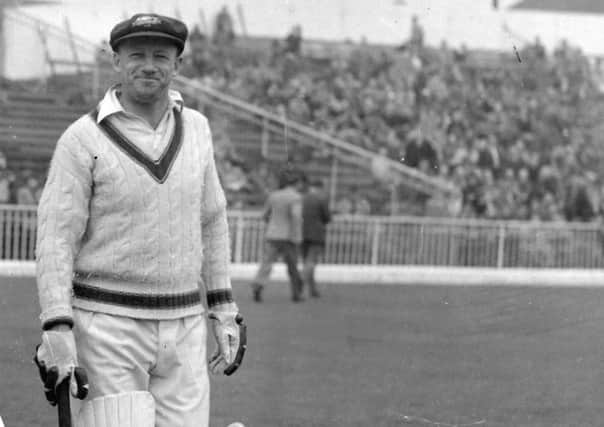Chris Waters: Bradman’s Headingley heroics rekindled by Warner’s knock


His name was Don Bradman.
On July 11, 1930, the legendary Australian scored 309 on the opening day against England at Headingley.
Bradman went on to make 334, beating the world record Test score of 325 achieved only three months earlier by the Surrey and England opening batsman Andrew Sandham against West Indies at Kingston.
Advertisement
Hide AdAdvertisement
Hide AdJust one month short of his 22nd birthday, Bradman was on his maiden tour of England and had already caused a huge stir.
Six weeks earlier, he had become only the fifth man – and the first from overseas – to score 1,000 runs before the end of May, the Hampshire captain Lord Tennyson obligingly agreeing to play on in sheeting rain at Southampton to allow him to reach the milestone.
Bradman had hit 131 in the first Test against England at Trent Bridge, 254 in the second at Lord’s – an innings he always rated his greatest – and arrived at Headingley for the third Test amid a hail of publicity.
The newspapers billed the game as “Bradman v England” – and so it turned out, although rain prevented a finish with the series level at 1-1.
Advertisement
Hide AdAdvertisement
Hide AdOn a first day buffeted by an unseasonably cold wind, Bradman came to the crease in the second over after Archie Jackson had been caught by Harold Larwood off Maurice Tate.
Larwood, the Nottinghamshire fast bowler, always maintained that he had Bradman caught behind without scoring and that the prodigy should have walked.
“The first ball I gave him was a bouncer, and he snicked it,” said Larwood. “You could hear the snick all over the ground.
“George Duckworth caught it, and you could hear his appeal in Manchester. We all went up. I knew he’d snicked it, and everyone who was close to it will tell you the same.
Advertisement
Hide AdAdvertisement
Hide Ad“Even Jack Hobbs, who would never appeal unless he thought a man had a good chance of being out, shouted with us.
“I didn’t complain at the time. The umpire just gave him the benefit of the doubt.”
If Bradman was fortunate, he made the most of it.
At lunch, he had 105 to his name; at tea, 220, and then he hit 89 in the final session.
At stumps, Bradman, pictured, was 309 not out and Australia were 458-3.
Advertisement
Hide AdAdvertisement
Hide Ad“A nice bit of practice for tomorrow,” he said after unbuckling his pads.
The Times wrote: “To mention the strokes from which he scored most of his runs is to go through the whole range of strokes known to a modern batsman.
“Once or twice he demonstrated an idea which is not generally understood, but at no time did he take anything approaching a risk, and he cannot have hit the ball in the air more than three times during the day.
“It was, in fact, an innings so glorious that it might well be classed as incomparable, and how the Yorkshiremen loved it.”
Advertisement
Hide AdAdvertisement
Hide AdThe Times said the English bowling was “colourless and undistinguished” and that Larwood was “comfortable to the batsmen”.
Bradman had a life on 273 when he was missed at the wicket off George Geary but was otherwise commanding.
Shortly before he resumed his innings on day two, Bradman was handed a telegram: “Your house is on fire and your girl wants you back – go home.”
He laughed at the joke and went on to reach 334 before Duckworth finally had him caught behind off pace bowler Tate.
Advertisement
Hide AdAdvertisement
Hide AdIt remained the highest individual Test score until 1933, when Wally Hammond hit 336 not out for England against New Zealand at Auckland.
In recognition of his efforts, Bradman was given £1,000 by an admirer (about £40,000 today), a gesture that unwittingly caused a stir.
For the Australians – staying at the Queens Hotel next to Leeds railway station – were keen to celebrate their team-mate’s triumph.
However, Bradman preferred, as he so often did, to stay in his room to write letters and listen to music, and he declined the suggestion that he might buy them all a drink and take them out to dinner.
Advertisement
Hide AdAdvertisement
Hide AdIf such a stance did not always make him the most popular of colleagues, there was no doubting his popularity with the cricketing public.
The Yorkshire crowd afforded him a wonderful reception, and he later said that “the opening day of the Third Test at Leeds must rank as the greatest of my cricketing life”.
After a rain-hit fourth Test in Manchester, Bradman made 232 in the final Test at the Oval as Australia won by an innings to take the series 2-1.
He ended the rubber with 974 runs at an average of 139.14.
Like most of his records, it will almost certainly never be broken.
And another thing...
Advertisement
Hide AdAdvertisement
Hide AdTHE England and Wales Cricket Board took the unusual step on Friday of tweeting a clarification concerning comments reportedly made by England’s director of cricket Andrew Strauss.
National newspapers reported the former England captain as suggesting that leading Test players will, in future, be allowed to skip Tests to play in T20 tournaments such as the Indian Premier League in an effort to improve England’s one-day fortunes.
But it appears to have been a case of crossed wires as the governing body followed up by publishing the following remarks from the ex-opening batsman.
“I can’t foresee any circumstances in which we would weaken our Test team in order to allow a player to play in the IPL or any other franchise-based competition,” said Strauss.
“This is about striking the right balance in the long-term between red and white-ball cricket and giving players greater opportunities to improve in both formats.”
Fair enough, then.